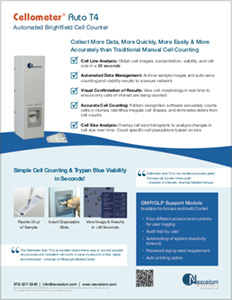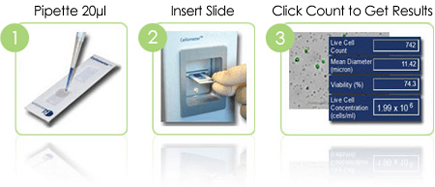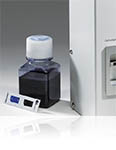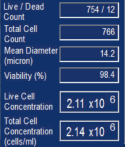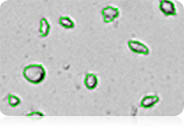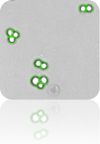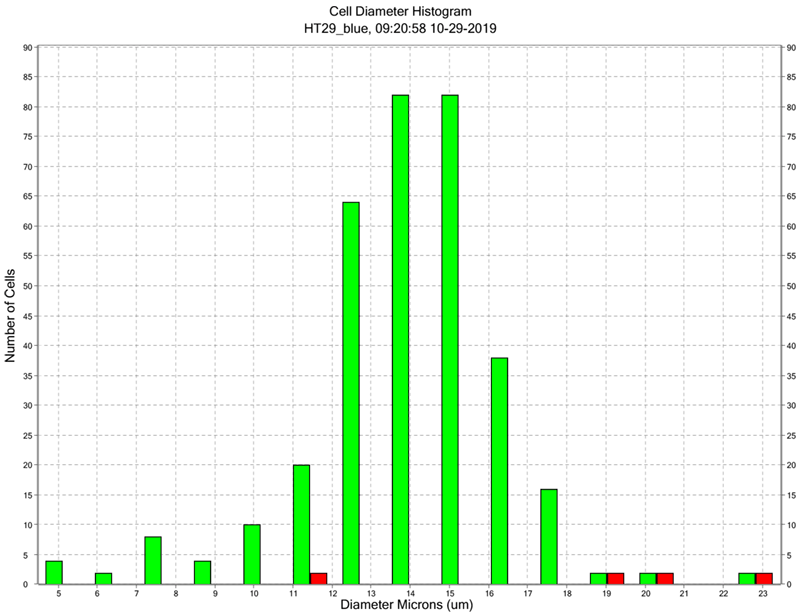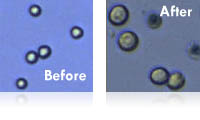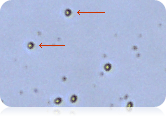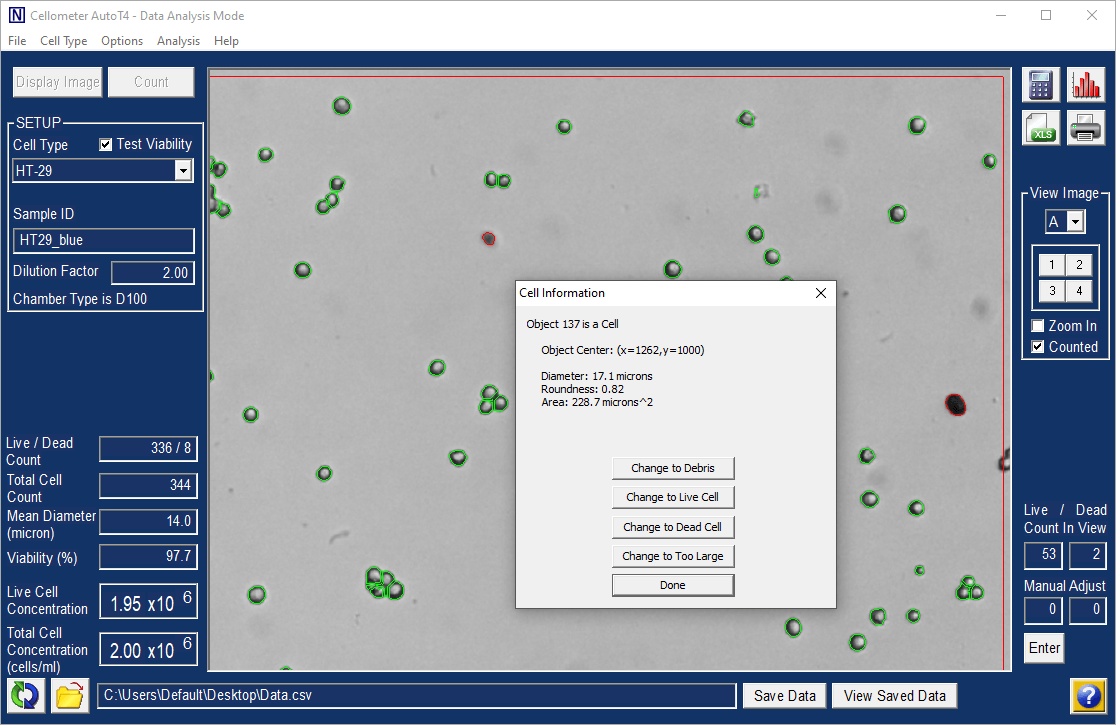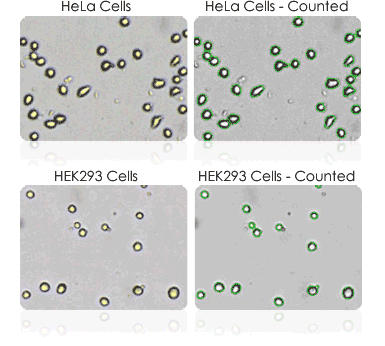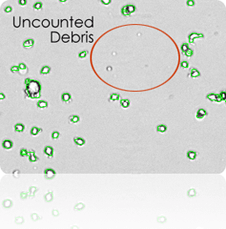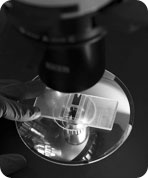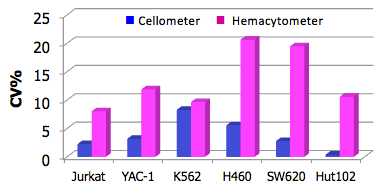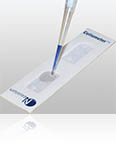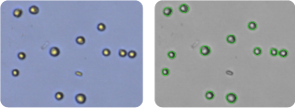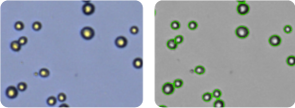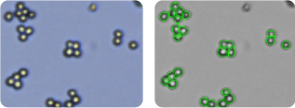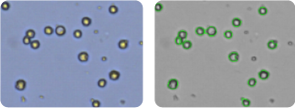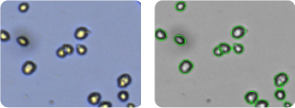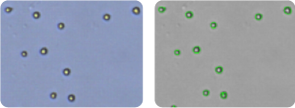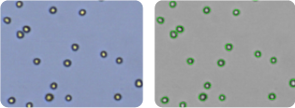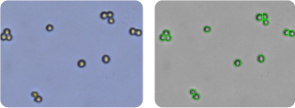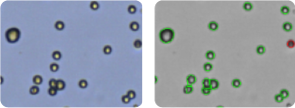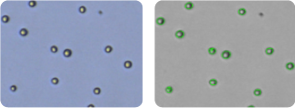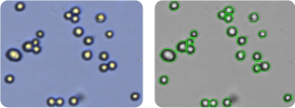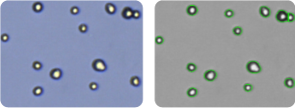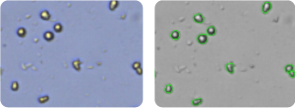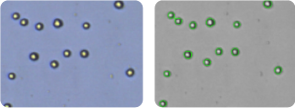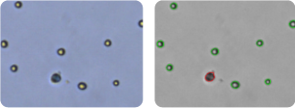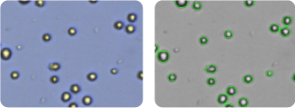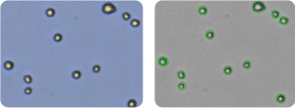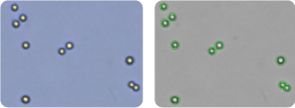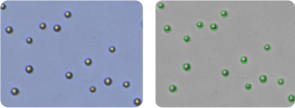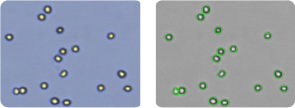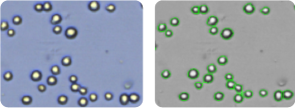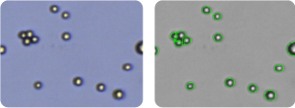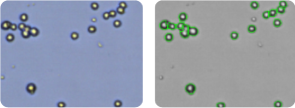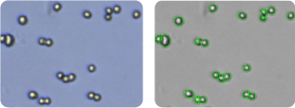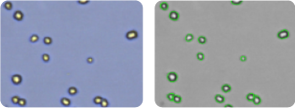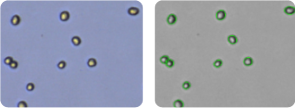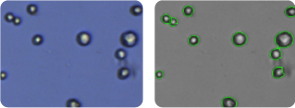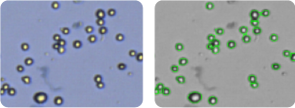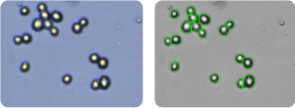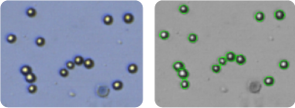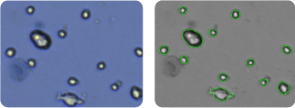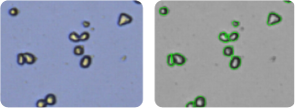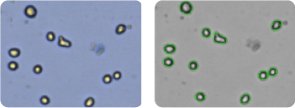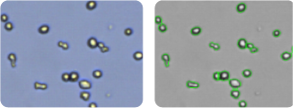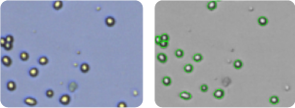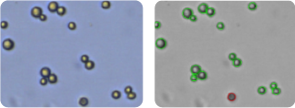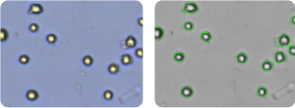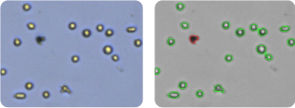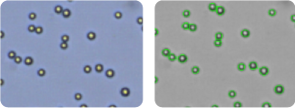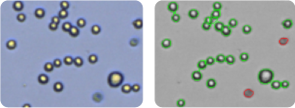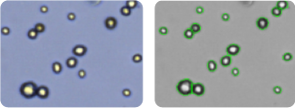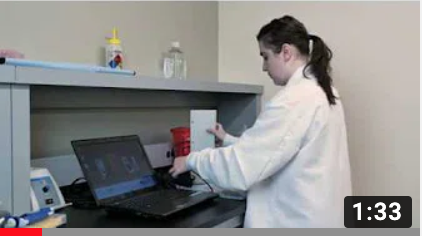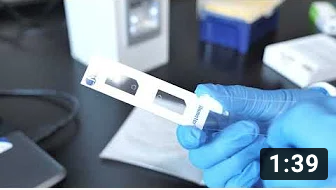Cellometer Auto T4 Bright Field Cell Counter
Automated cell counter for trypan blue viability for cell lines
Introduction to the Cellometer Auto T4 Bright Field Cell Counter
Cell Counting Made Simple
Brightfield cell counting is recommended only for cell lines or purified/homogenous primary samples. Fluorescence cell counting is recommended for PBMCs, mouse splenocytes, hepatocytes, and other similar primary nucleated cell samples. To see our excellent line of fluorescent cell counters, please visit our fluorescent cell counters page.
Simple, Automated Cell Counting in Less than 10 Seconds
The Auto T4 utilizes bright field imaging and pattern-recognition software to quickly and accurately identify and count individual cells. Cell count, concentration, diameter, and % viability are automatically calculated and reported.
Load Sample, View Image, Count Cells, and Obtain Results in less than 10 seconds
The Auto T4 Cell Counter offers:
-
On screen view of individual cell level information
-
Ability to capture multiple fields of view for highly accurate data
-
Built-in cell type library
-
Count difficult cells (clumpy, irregular-shaped)
- Options for IQ/OQ Validation and GMP/GLP software
One-step Concentration & Viability
The Auto T4 simultaneously calculates cell concentration and % viability for cultured cells stained with trypan blue.
Trypan blue viability is a dye exclusion method that utilizes membrane integrity to identify dead cells. The dye is unable to penetrate healthy cells, so they remain unstained. Dead cells have a compromised cell membrane that is permeable to the trypan blue dye. Dead cells are stained blue and display as dark cells in the Cellometer software with bright field imaging.
Within 10 seconds, the Auto T4 instrument reports:
- Live, dead, and total cell count
- Live and total cell concentration
- Mean Cell Diameter
- % Viability
Counted bright field Image
Live cells = green circle
Dead (stained) cells = red circle
Analyze >99% of Cultured Mammalian Cells, including NCI-60 and clumpy MCF-7 cells
NCI-60 is a group of 59 human cancer cell lines (originally 60) developed by the National Cancer Institute for screening purposes. Isolated from various tissues (bone marrow, lung, ovary, brain, skin, breast, colon, kidney, prostate), the cell lines are used extensively to screen experimental cancer drug compounds and study tumor development.
Irregular-shaped Cells
The Cellometer cell roundness setting can be adjusted for recognition and counting of irregular-shaped cells, such as RD cells and activated T-cells.
Clumpy Cells
The MCF-7 breast cancer cell line can be very clumpy. The Cellometer pattern-recognition software identifies and counts individual cells within these cell clumps for accurate analysis (shown at left).
- 57% of the NCI-60 cell lines are clumpy, contain debris, or display large variations in cell shape or size.
- All 59 NCI-60 cell lines have been successfully validated on the Cellometer Auto T4 Cell Counter.
Cell Size Analysis & Size-based Counting
The Auto T4 Cell Counter Automatically generates a cell size histogram based on cell diameter.
Because Cellometer generates individual cell size measurements, multiple samples can be overlaid on one histogram enabling analysis of the change in cell diameter over time.
For experiments involving SF9 or SF21 cells, saved images can be viewed and re-counted to analyze changes in morphology over time.
The minimum and maximum cell diameter settings can be optimized to count specific cells in a sample.
This example demonstrates counting of mature dendritic cells cultured from PBMCs based on cell diameter.
Multiple Cell Images for Data Verification
No two cells are the same. With the Auto T4 Cell Counter, cell morphology can be immediately viewed on-screen.
Two images with four fields of view each are captured per cell count. This is equivalent to the area of four quadrants of a hemocytometer. Counted cells are indicated on-screen for further verification that cells in the sample are being imaged and analyzed properly.
Users can confirm that:
- Cells are counted correctly, based on size and shape
- Debris is excluded
- Cells within clumps are being counted individually
- Cell images can be archived and exported for use in publications and presentations.
- Saved images can be re-counted using default or user-optimized analysis settings.
Exclusion of Debris
Because Cellometer recognizes cells based on size, brightness, and morphology, cellular debris is easily and accurately excluded from counting results.
- Cell size parameters can be modified to optimize exclusion of debris from results and enhance the accuracy of counting for a wide range of cell sizes.
- The counted image can be viewed to verify exclusion of debris from results.
10x Faster and More Precise than Manual Counting
Counting 1 x 106 cells takes approximately 5 minutes with a manual hemacytometer. Counting live and dead cells sometimes takes twice as long. The Cellometer Auto T4 Cell Counter calculates cell count and concentration for live and dead cells and % viability in just 10 seconds.
Cellometer Precision
The Cellometer %CV (Coefficient of Variation), including sample preparation, was well under 5% for most cell lines tested. The CVs for manual counts ranged from 7% to 20%. Automated cell counters remove inter-operator variability and subjectivity from cell counts to generate more precise data.
Improve Data Accuracy & Consistency
- Eliminate Wash Steps
- Eliminate Judgment Errors
- Eliminate Recording & Calculation Errors
- Reduce Counting Time … Run More Experiments
| Cellometer Auto T4 | Hemacytometer | |||||
|---|---|---|---|---|---|---|
| Concentration | n | CV | Concentration | n | CV | |
| Jurkat | 1.17 x 106 | 4 | 2.27% | 1.11 x 106 | 3 | 8.04% |
| YAC-1 | 1.36 x 106 | 4 | 3.17% | 1.41 x 106 | 3 | 11.89% |
| K562 | 6.36 x 105 | 4 | 8.29% | 5.58 x 105 | 3 | 9.66% |
| H460 | 1.32 x 106 | 4 | 5.57% | 1.16 x 106 | 3 | 20.65% |
| SW620 | 3.81 x 105 | 4 | 2.79% | 3.70 x 105 | 3 | 19.49% |
| Hut 102 | 9.18 x 105 | 4 | 0.39% | 7.68 x 105 | 3 | 10.60% |
Optional GMP and GLP Support Software License
For laboratories that require QC access and audit controls, optional GMP/GLP software can be added to the Auto T4 Cell Counter
Features
- Audit trail
- Multi-layer access control
- Auto printing by a custom template
Easily Print & Save Data and Cell Images
Easily Export to Excel for additional data formatting or sharing. Images and data tables can be pasted into PowerPoint presentations or submitted for publication.
Easily Save data and images to a network or local computer. View sample data file.
Print directly from the software screen. The standard printout displays live, dead, and total cell count and concentration, % viability, and cell images. View sample report.
Counting Chambers — No Washing or Contamination
Cellometer Disposable Counting Chambers consist of two independent enclosed chambers with a precisely controlled height. Cell suspension of 20 microliters is loaded into the chamber using a standard single channel pipette. The chamber is inserted into the Cellometer cell counter and the cells are imaged. This simple sample loading and analysis method is ideal for fragile cells.
The disposable Cellometer Cell Counting Chambers offer several key advantages:
- Time savings — no washing
- No risk of cross-contamination
- Reduced biohazard risk to users
- Controlled sample volume
- Large-depth chambers for large cells
- Most affordable automated counting consumables
Cellometer Auto T4 Accessories
IQ / OQ Validation Package
Installation Qualification (IQ) and Operational Qualification (OQ) package for the Auto T4 Cell Counter
| Catalog # | Description | Size | Unit |
|---|---|---|---|
| Cellometer Auto T4-IQOQ | Counting chambers, reference bead solution, and validation protocol for the Cellometer Auto T4 | 100 counts | 1 Set |
On-Site Service, Maintenance, and Instrument Warranties
Trained Nexcelom Applications Specialists are available for on-site preventative maintenance, IQ validation, and OQ validation.
| Service | Description |
|---|---|
| Preventative Maintenance | Available for all Cellometer Systems Please inquire about scheduling and pricing. |
| IQ Validation* | Available for Auto T4 and Vision Systems Please inquire about scheduling and pricing. |
| OQ Validation* | Available for Auto T4 and Vision Systems Please inquire about scheduling and pricing. |
| Extended Warranty | Available for all Cellometer Systems currently under a valid warranty. Please inquire for pricing. |
*IQ/OQ Validation Package must be purchased separately
Dedicated On-line and On-site Applications Support
Clicking “Submit a Support Ticket” launches a convenient on-line form that is submitted directly to Nexcelom Technical Support
- T4 instrument information fields are automatically populated
- Images are easily attached for troubleshooting and applications support
- A Nexcelom Specialist can assume remote control of the Auto T4 Cell Counter for troubleshooting and training
Applications for Cellometer Auto T4 Bright Field Cell Counter
NCI-60 Cancer Cell Lines
Automatically measure live cell concentration and viability of cancer cell lines used in oncology research and most of all biology research. »
Insect Cells
Automatically measure live cell concentration, viability for baculovirus infected insect cells. Cell size histogram live cell concentration and viability are generated within less than 60 seconds using 20 µl sample. »
Stem Cells
Automatically measure live cell concentration and viability for stem cells, such as human and mouse ES cells, mesenchymal, cardiac, induced pluripotent stem cells. Multiple viability stains, such as trypan blue, propidium iodide are used to identify dead cells. For samples with a lot of debris, dual fluorescent nuclear stains are used for live and dead cells. »
Cell Viability Measurement Using Trypan Blue or AO/PI
When should you use trypan blue and when should you use acridine orange/propidium iodide to measure cell viability? »
Cell Size Assay
Performing cell size measurement assay and using cell size to count cells within preset cell size parameters. For adipocytes, stem cells, Sf9 cells, dendritic cells, and others. »
Cancer Cell Lines Counted with the Cellometer Auto T4
Cell Characteristics are based on observation in a Cellometer Counting Chamber. For adherent cell lines, cell characteristics are based on the appearance of cells following trypsinization.
786-O
Origin: Kidney
Cell Characteristics: Round, normal size distribution
A498
Origin: Kidney
Cell Characteristics: Round, some size variation
A549/ATCC
Origin: Lung, NSCLC
Cell Characteristics: Round, normal size distribution, clusters > 5 cells
ACHN
Origin: Kidney
Cell Characteristics: Mostly round, normal size distribution, clusters < 5 cells, debris
CAKI-1
Origin: Kidney
Cell Characteristics: Large variation in morphology
CCRF-CEM
Origin: Leukemia
Cell Characteristics: Round, normal size distribution
COLO 205
Origin: Intestine
Cell Characteristics: Round, normal size distribution
DU145
Origin: Prostate
Cell Characteristics: Round, normal size distribution, clusters < 5 cells
EKVX
Origin: Leukemia
Cell Characteristics: Round cells, variable size distribution, clusters < 5 cells
HL-60
Origin: Leukemia
Cell Characteristics: Round, normal size distribution
HOP-62
Origin: Lung, NSCLC
Cell Characteristics: Round cells, some size variation, cell clusters < 5 cells
HOP-92
Origin: Lung: NSCLC
Cell Characteristics: Round cells, some size variation
HS 578T
Origin: Breast
Cell Characteristics: Large variation in morphology, debris
HT-29
Origin: Intestine
Cell Characteristics: Round, normal size distribution, clusters < 5 cells
K562
Origin: Leukemia
Cell Characteristics: Round, normal size distribution
LOX IMVI
Origin: Skin
Cell Characteristics: Large variation in morphology, debris
M-14
Origin: Skin
Cell Characteristics: Round, some variation in size
MALME-3M
Origin: Skin
Cell Characteristics: Round, normal size distribution
MDA-MB-231/ATCC
Origin: Breast
Cell Characteristics: Round, some size variation, some debris
MDA-MB-435
Origin: Breast
Cell Characteristics: Round, some size variation
MDA-MB-468
Origin: Breast
Cell Characteristics: Round, normal size distribution, some clusters < 5 cells
MOLT-4
Origin: Leukemia
Cell Characteristics: Round, normal size distribution
NCI/ADR-RES
Origin: Ovary
Cell Characteristics: Round, normal size distribution
NCI-H226
Origin: Lung, NSCLC
Cell Characteristics: Round, some size variation, some clusters < 5 cells
NCI-H23
Origin: Lung NSCLC
Cell Characteristics: Round, normal size distribution, some clusters < 5 cells
NCI-H322M
Origin: Lung, NSCLC
Cell Characteristics: Round, normal size distribution, some clusters < 5 cells
OVCAR-4
Origin: Ovary
Cell Characteristics: Round, some size variation, clusters < 5 cells, some debris
OVCAR-5
Origin: Ovary
Cell Characteristics: Round, some size variation, clusters < 5 cells
OVCAR-8
Origin: Ovary
Cell Characteristics: Round, normal size distribution, some clusters < 5 cells
PC-3
Origin: Prostate
Cell Characteristics: Round, normal size distribution
RPMI 8226
Origin: Leukemia
Cell Characteristics: Round, size variation
SF-268
Origin: Brain
Cell Characteristics: Round, some size variation, clusters < 5 cells
SF-295
Origin: Brain
Cell Characteristics: Round, some size variation, clusters < 5 cells
SF-539
Origin: Brain
Cell Characteristics: Round, normal size distribution, some clusters < 5 cells
SK-MEL-2
Origin: Skin
Cell Characteristics: Large variation in morphology and size
SK-MEL-5
Origin: Skin
Cell Characteristics: Variation in morphology and size
SK-MEL-28
Origin: Skin
Cell Characteristics: Variation in morphology and size
SK-OV-3
Origin: Ovary
Cell Characteristics: Variation in morphology and size, some clusters < 5 cells
SN-12C
Origin: Kidney
Cell Characteristics: Round, normal size distribution
SNB-19
Origin: Brain
Cell Characteristics: Round, some size variation, clusters < 5 cells
SNB-75
Origin: Brain
Cell Characteristics: Round, some variation in size and morphology
SR
Origin: Lymphoma
Cell Characteristics: Large variation in morphology
SW620
Origin: Intestine
Cell Characteristics: Round, normal size distribution, some clusters < 5 cells
T-47D
Origin: Breast
Cell Characteristics: Large variation in morphology and size, some clusters < 5 cells
UACC-257
Origin: Skin
Cell Characteristics: Large variation in size and morphology, some clusters < 5 cells
Performance of the Cellometer Auto T4 Cell Viability Counter
Consistency and Accuracy Comparison to Hemacytometer
Jurkat
| N=20 | Hemacytometer | Auto T4 |
|---|---|---|
| Average | 1.03E+06 | 1.08E+06 |
| STDEV | 6.60E+04 | 1.01E+05 |
| %CV | 6.4% | 9.4% |
5 µm beads
| N=20 | Hemacytometer | Auto T4 |
|---|---|---|
| Average | 1.07E+06 | 1.03E+06 |
| STDEV | 5.90E+04 | 6.46E+04 |
| %CV | 5.5% | 6.3% |
Models and Specifications for Cellometer Auto T4 Bright Field Cell Counter
| Includes | • Cellometer Auto T4 Instrument • Cellometer Software • USB 2.0 Connection Cable • Power Supply • Phone/online applications support during set-up |
|---|---|
| Available Accessories | PC laptop |
| Imaging Performance | Cell Size: 5 – 60 microns (most mammalian cells) Conc. Range: 105 – 107 cells/mlBright field imaging and pattern-recognition software to quickly and accurately decluster, identify and count individual cells. |
| Instrument Specifications | Weight: 10.4 lbs. (4.7kg) Width: 3.5″ (8.9 cm) Depth: 4.2″ (10.7 cm) Height: 12.6″ (32.0 cm)Input to Power Adapter: 100-240 VAC, 50/60 Hz, 0.5A Output to Instrument: 12 VDC, 1.5A |
| PC / Laptop requirements: (If purchasing Cellometer without PC laptop) | • Windows 7, 8 or 10 • 1.6 GHz or higher processor • 2GB RAM • USB 2.0 port • Display resolution: 1024 x 768 pixels or higherIntel Mac with Parallels/Windows |
Auto T4 Resources
Manuals
Application Notes
- Cell Counting Repeatability and Consistency on the Auto T4 Cell Counter
- Alternative Image-Based Technique for Phytoplankton Cell Counts in Shellfish Aquaculture
- Insect Cell Counting and Size Analysis Using Cellometer Auto T4 Cell Counter
Product Literature
- Flyer – Cellometer Auto T4 Cell Counter
- Spec Sheet – Cellometer Auto T4 Cell Counter
- Protocol – Cellometer Auto T4 Cell Counter
Blog Posts
- 10 Questions to Ask Before Purchasing an Automated Cell Counter
- Don’t let clumpy samples prevent you from getting an accurate count!
Publications
- Cellometer Auto T4 investigates dysfunction to pro-inflammatory cytokine toxicity and reactive oxygen species
- Cellometer T4 supports research into the chemoprotective effects of aspirin in a variety of cancer cell lines
- Cellometer Auto T4 evaluates the cytotoxic potential of mouth rinses
- Cellometer Auto T4 is used to uncover novel targets for Graves’ Orbitopathy therapeutics
- Cellometer T4 work in Adoptive Cell Transfer examines gender differences in pathology after stroke
- French Institute for Health and Medical Research and the University of Lyon use Cellometer Auto T4 for Trypan Blue Viability
- Cellometer T4 studies immune response to Delftia bacteria sometimes found in IV catheters
Training Videos
Customer Testimonials
Highly recommended from a colleague
The Auto T4 Cellometer is easy to set up and intuitive to use. Our lab is crowded and the compact size allowed us to squeeze it into the small amount of spare space we have. This counter came highly recommended from a colleague and so we had to get one for ourselves. It has made counting cells far more accurate and easier for us compared to our old counters and shared equipment.
function positionLinkBlock(targetContainer) { if (targetContainer != null) { var strLinkBlock = 'Highly recommended from a colleague
The Auto T4 Cellometer is easy to set up and intuitive to use. Our lab is crowded and the compact size allowed us to squeeze it into the small amount of spare space we have. This counter came highly recommended from a colleague and so we had to get one for ourselves. It has made counting cells far more accurate and easier for us compared to our old counters and shared equipment.
A time-saving machine
Cellometer [T4] has greatly reduced the time it takes to count the cells. There is a large library of settings for different type of cells. However, creating settings for a new cell type is very easy. Overall, its reliable and a time-saving machine.
function positionLinkBlock(targetContainer) { if (targetContainer != null) { var strLinkBlock = 'User-friendly
Good Purchase. Cell counting has been made easier through the Cellometer Auto T4 instrument. The software is easy to access and user-friendly. Handling of the instrument is also user-friendly.
function positionLinkBlock(targetContainer) { if (targetContainer != null) { var strLinkBlock = 'Great
It is easy to operate. It looks like a simple instrument, yet provides complete information of the cell counting: viable cells, dead cells, viability, total cell numbers. It also provides cell sizes and distribution that are very informative to help you know your cells better. This instrument is already trained for many commonly used cells in the lab. Great.
function positionLinkBlock(targetContainer) { if (targetContainer != null) { var strLinkBlock = 'Great
It is easy to operate. It looks like a simple instrument, yet provides complete information of the cell counting: viable cells, dead cells, viability, total cell numbers. It also provides cell sizes and distribution that are very informative to help you know your cells better. This instrument is already trained for many commonly used cells in the lab. Great.
Would definitely recommend
Cellometer Auto T4 has made my life easy. Now I don’t have to manually count the cell number on a neubauer chamber under the microscope and stress my eyes. Cellometer is very easy to use, fast and accurate. The best thing is that I can optimize the settings for counting different cells on the basis of size and it can even count clumpy cell lines. I would definitely recommend this instrument to everyone.
function positionLinkBlock(targetContainer) { if (targetContainer != null) { var strLinkBlock = 'Shweta Singh
Would definitely recommend
Cellometer Auto T4 has made my life easy. Now I don’t have to manually count the cell number on a neubauer chamber under the microscope and stress my eyes. Cellometer is very easy to use, fast and accurate. The best thing is that I can optimize the settings for counting different cells on the basis of size and it can even count clumpy cell lines. I would definitely recommend this instrument to everyone.
Shweta Singh
Very easy to use
The Auto T4 is very easy to use and the software is very friendly. I save a lot of time when I count number of cells and more when I am using more than one cell line.
function positionLinkBlock(targetContainer) { if (targetContainer != null) { var strLinkBlock = 'The customer service is good too
We use [Cellometer] to count PBMC and tumor cells, Auto T4 is easy and good to use for measuring. The customer service is good too, willing to come and help set the optimization of the instrument. We recommend not only these machines, but this company also.
function positionLinkBlock(targetContainer) { if (targetContainer != null) { var strLinkBlock = 'Unique features
We purchased [Cellometer] Auto T4 half-a-year ago, and were very happy with it. It has some unique features not avail on the other counters. I like the capability of the counter to show you which cells were counted. It is usually very accurate in picking up cells, including detecting individual cells in clusters and excluding all junk.
function positionLinkBlock(targetContainer) { if (targetContainer != null) { var strLinkBlock = 'Alexei Kisselev
Unique features
We purchased [Cellometer] Auto T4 half-a-year ago, and were very happy with it. It has some unique features not avail on the other counters. I like the capability of the counter to show you which cells were counted. It is usually very accurate in picking up cells, including detecting individual cells in clusters and excluding all junk.
Alexei Kisselev
Reproducible results
[Cellometer] Auto T4 is easy to use and allow us to get a reproducible result. We are satisfied with the function. It gets better if you have the autofocus function.
function positionLinkBlock(targetContainer) { if (targetContainer != null) { var strLinkBlock = 'Speeds up my work significantly
The [Cellometer] Auto T4 is accurate and easy to use. It speeds up my work significantly. I love it!
function positionLinkBlock(targetContainer) { if (targetContainer != null) { var strLinkBlock = 'Ningwu Huang
Fast and reliable
The [Cellometer] Auto T4 is a fast and reliable way to count various types of cells and the option to export directly to Excel allows for easy E-notebook integration.
function positionLinkBlock(targetContainer) { if (targetContainer != null) { var strLinkBlock = 'Very convenient and time-saving
The [Cellometer] Auto T4 we have in the lab is a very convenient and time-saving instrument, especially, when we have a lot of samples to quantify the cell number and cell viability. We like it very much!
function positionLinkBlock(targetContainer) { if (targetContainer != null) { var strLinkBlock = 'Sherleen Adamson
Customer Publications using Cellometer Auto T4
Our customers include:



